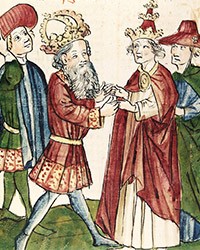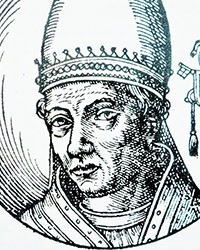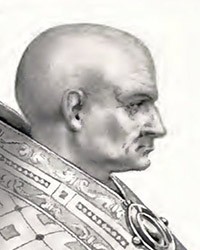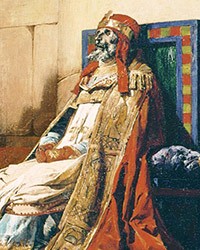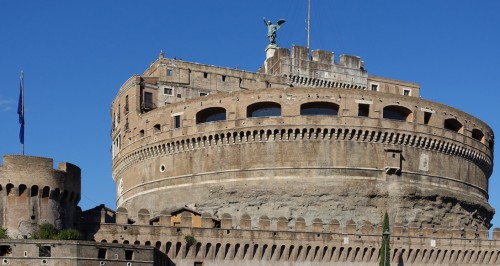
Castle of St. Angel's - the residence of Marozia in Rome
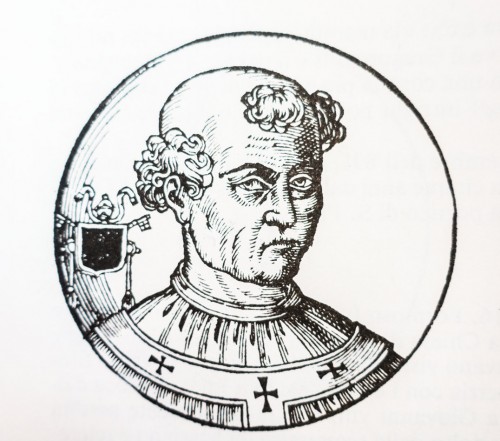
Pope Formosus, Le vite dei pontifici, 1710, Bartolomeo Platina
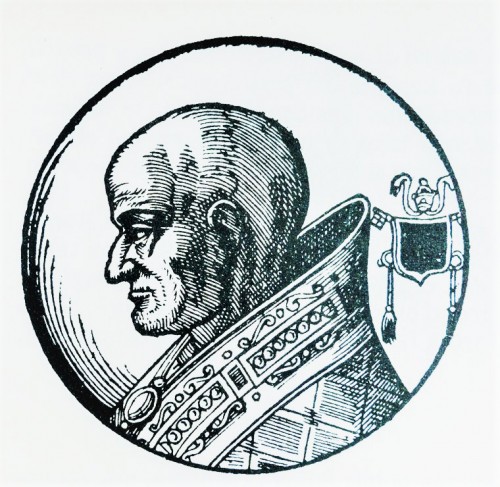
Pope Sergius III, Le vite dei pontifici, 1710, Bartolomeo Platina
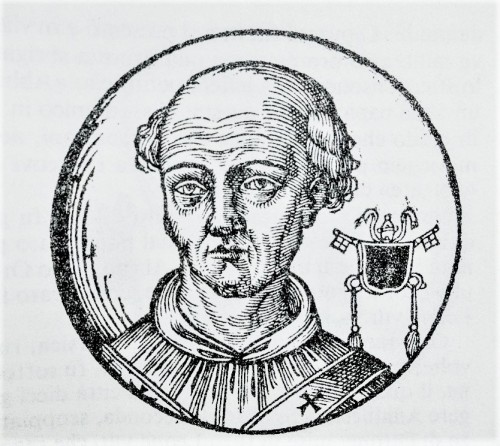
Pope John XII, Le vite dei pontifici, 1710, Bartolomeo Platina
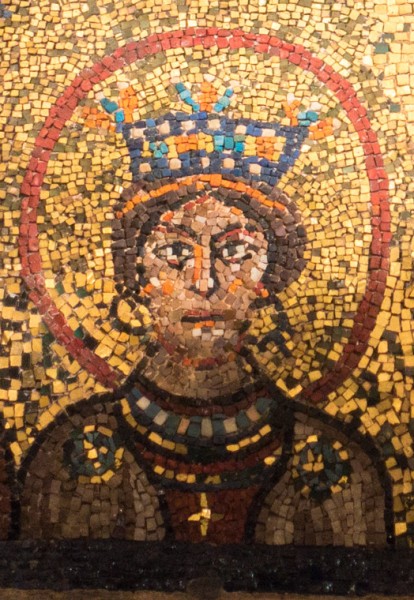
Image of a noble family lady from the IXth century (one of the saints) - mosaic in the Basilica of S. Prassede
For nearly twenty years she ruled Rome, placed her favorites on St. Peter’s throne, or removed them from it. She was driven by ambition and a desire for power, which were helped by her talent, intelligence, grace, and something which she probably possessed in abundance – a lack of scruples. As the unfavorably disposed towards her chronicler Liutprand of Cremona claimed, Mariozza (since that is what she was called) “ was as beautiful as a goddess and as fiery as a wench”, which was to additionally elevate her qualifications to lead all men by their noses. However, how much of this negative portrait is the truth and how much is propaganda?
For nearly twenty years she ruled Rome, placed her favorites on St. Peter’s throne, or removed them from it. She was driven by ambition and a desire for power, which were helped by her talent, intelligence, grace, and something which she probably possessed in abundance – a lack of scruples. As the unfavorably disposed towards her chronicler Liutprand of Cremona claimed, Mariozza (since that is what she was called) “ was as beautiful as a goddess and as fiery as a wench”, which was to additionally elevate her qualifications to lead all men by their noses. However, how much of this negative portrait is the truth and how much is propaganda?
The political situation on the Apennine Peninsula at the end of the IX century was, as we would have said today, dynamic, while high-born men occupied themselves with armed invasions and political games with the aim of attaining the greatest power and influence. Death in their ranks was a daily occurrence and it was a rare thing indeed for someone to die of natural causes. Killing and assassinating, they struggled for their own survival and the safety of their loved ones. Nobody thought of putting a halt to this excessive violence – it was daily bread. In 897 the Romans witnessed the unprecedented Cadaver Synod, in which the corpse of Pope Formosus taken out of its tomb, took part – desecrated, cast into the Tiber, taken out, then once again desecrated. These were probably the memories of Marozia’s childhood, whose parents – Theophylact (consul from Tusculum and a Roman senator) and Theodora the Elder, were some of the most influential people running the city, the true elite. Her father who also called himself a duke, was the leader of the Roman aristocracy and he was the one who designated popes who were favorable towards him and his caste. This was the case all the way until his death, which occurred in 925. Then it was Marozia who took his place along with her subsequent husbands. She herself held no official function within the city, but she ruled it for seven years, this being fully accepted by the Romans.
However, before we move on to Marozia, it must be underlined, that our knowledge about her, which is rather limited, comes mainly from one source – the texts left behind by Liutprand of Cremona, a chronicler, whose protector was the King of the Eastern Franks, Otto I, at that time insignificant, but talented and ambitious ruler of Saxony, whose goal was to obtain the imperial crown. This could only come about through Pope John XII, who was the de facto grandson of Marozia. When this did occur, the emperor decided to get rid of him. Since he had to convince the Roman aristocracy, the brunt of his criticism was directed at the strongest enemy – the lords of Tusculum, from within whose ranks the pope came. A truly Goebbels-like propaganda of Liutprand of Cremona was however, focused not directly on them, but rather on the diabolical women from the family, who possessed all the men – one of these was Marozia, the other her sister Theodora the Younger, the third – her mother Theodora the Elder. Unfavorable or more appropriately insulting verses about Marozia are also repeated by the author of an opinion included in the most important document on the history of medieval Church, the Liber Pontificalis, in this way justifying the pathetic role which was at this time played by the popes.
Both these sources paint a portrait of Marozia as a girl, who at the age of fourteen became the lover of Pope Sergius III. The woman who led her to the pope’s bed was none other than her mother – Theodora and out of this relationship a boy named Alexander was conceived around the year 906. At that time Marozia was already the wife of a man worthy of her social status, the Duke of Spoleto, Alberic I. Whether her firstborn son was the fruit of a sinful relationship or not, we do not know. Marozia also gave birth (approx. 909-911) to a second son, who was given the name of Alberic II. His led a life – in those times of turmoil – that was calm and peaceful. The then pope, John X was an adversary of both her and her husband, however his dislike did not cross the boundaries. New challenges were placed in front of the approximately thirty-three-year-old woman by the death of her father and husband (approx. 925). She had to find another husband – protector. This was not difficult, since Marozia possessed not only authority in the city which was passed down from her parents, but also grace and beauty. Her choice was Guy of Tuscany, who turned out to be the appropriate partner for her behind the scenes games. Immediately after, Pope John X was removed from his office (928). Why? The details of these events are unknown. The reason (or pretext) for this could have been an accusation of bringing the Magyars onto papal lands, which occurred in 927. It was at that time that the brother of the pope, Peter, who had been previously exiled from the city returned and immediately after him the Magyars appeared. He was accused of binging them to Rome. However, Liutprand of Cremona simply claims that the pope fell out of the good graces of Marozia. This cannot be excluded. The close contacts of John X with the King of Italy, Hugh of Arles were a threat to the Roman aristocrats and thus also a threat to Marozia and her husband. Some historians claim that, after the death of Theophylact and Theodora the pope along with his brother had desired to bring about “the downfall” of Marozia and her family and at the same time take away their ability to control all the issues concerning the papacy. Spies of Marozia and Guy were to kill Peter at the Lateran Palace and immediately after lead to the imprisonment of Pope John X in the Castle of the Holy Angel, where he was soon murdered. This all took place with the blessing or even at the order of Guy and Marozia. In this very moment, both of them became, as Marozia’s parents had in the past the de facto rulers of Rome and controlled everything that happened there – including the selection of subsequent popes – Leo VI and Stephen VII. Liutprand of Cremona suggests, that the death of the latter was beneficial to Marozia and her ambitious plan to put her firstborn son Alexander, who took on the name of John XI (931) on St. Peter’s throne. She herself, vehemently resisted any insinuations that the over twenty-year-old Alexander was a fruit of her relationship with Pope Sergius III, claiming that he is the son of her first husband Alberic. In the meantime Guy of Tuscany died in 929 and Marozia even as the mother of a pope was fully aware of the weakness of her womanly position in the city. Her next choice was the stepbrother of her deceased husband – a recent enemy but currently a potential ally – the King of Italy Hugh of Arles. Marozia’s son, the pope, aided her in making this marriage formal, since as far as the law was concerned such a marriage was considered incest. And thus in March of 932 the forty-year-old matron impatiently awaited another strong shoulder to lean on, which entered the city with an army regiment and then the wedding took place. At that moment it could have seemed that Marozia had all the cards, now the queen of Italy, she was but a step away from the imperial crown for herself and her newly married husband, who would receive it without any problems from her son John XI. However, an unforeseen turn of events occurred and her young son and the pope’s brother – Alberic II – entered onto the pages of history. A month after the wedding an argument ensued between Marozia’s husband and her younger son. When the latter slapped by Hugh left Rome, nobody paid any attention to the seriousness of this situation. It was only noticed when Alberic II at the head of armed regiments returned to the city, this time with a cry (according to Liutprand of Cremona) that it is time to put an end to the rule of harlots. His words were to refer to both his mother and his aunt Theodora the Younger. The terrified Hugh of Arles escaped, while Marozia remained believing that the family quarrel could be solved. Imagine her surprise when her son came to her with a specific plan. She was imprisoned and locked away in a monastery, which she never again managed to leave, despite numerous armed attempts made by her husband. Twice he lay siege to the city walls and twice he had to abandon it. Marozia’s other son the pope – John XI, was also of no help, imprisoned on the Lateran and incapacitated by his brother, who in turn became the de facto ruler of Rome for the next quarter of a century.
Marozia died forgotten and alone in 936 (?). She was buried in Rome in a today non-existent Monastery of San Ciriaco at via Lata. Her plans of continuing the politics of her father and in this way ruling the city on the Tiber were put into effect by her son Alberic II and later her grandson Pope John XII. And it would be he and his allies who would truly become the enemies of Otto I, who would be aided by his efficient propaganda writer Liutprand of Cremona. Legends about Marozia were still created. One of them – with rather specific moral implications – arose at the imperial court of Otto. According to her, Marozia sentenced to prison had been dying in it for decades as an old woman. It was then, that Pope John XV (985-996) who showed mercy to her in a rather peculiar way. He sent a bishop to her in order to have him exorcise the devil, who apparently still ruled the soul of the ninety-four-year-old woman. It was only afterwards that she was to be executed. One day prior to her death Marozia was visited by the six year old at that time, grandson of Otto I, the latter Emperor Otto III. Apparently he had desired to see firsthand a woman who was the lover of one pope, the mother of another, the aunt of still another and finally the grandmother of a fourth one. After the sentence had been read, which recounted all her faults, as well as those of her son and grandson, the executioner entered the chamber and suffocated Marozia with a pillow. In this way justice was done.
For the Church, but also for its critics, Marozia became the embodiment of evil, while the word mentioned together with her name pornocracy, meaning the rule of harlots only strengthened the shame which fell upon the Church.
Even if she was not the embodiment of all virtues and she did lead to the murder of John X (of which there is no direct evidence), it would be unfair to say that her behavior was very different than that which was practiced by men. Nevertheless, the fact that she was a woman made the whole situation seem like an exceptional sin, while her constantly highlighted sexuality carried with it the signs of diabolism, which in a way justified the enslaved men – her victims. However, let us not forget than we know her from texts full of insults as well as rumors with no proof, which still today are treated as historical sources.
However, there was something else left behind by Marozia. As some researchers claim (e.g. Edward Gibbon), it was her figure that gave rise to the legend of Popess Joan, who had for centuries lived on in the imagination of the people of the Middle Ages and subsequent epochs. She was the emanation of a deep conviction, that a woman cannot occupy a leading position in a man’s world and most of all cannot be above the popes and rule over their heads.













